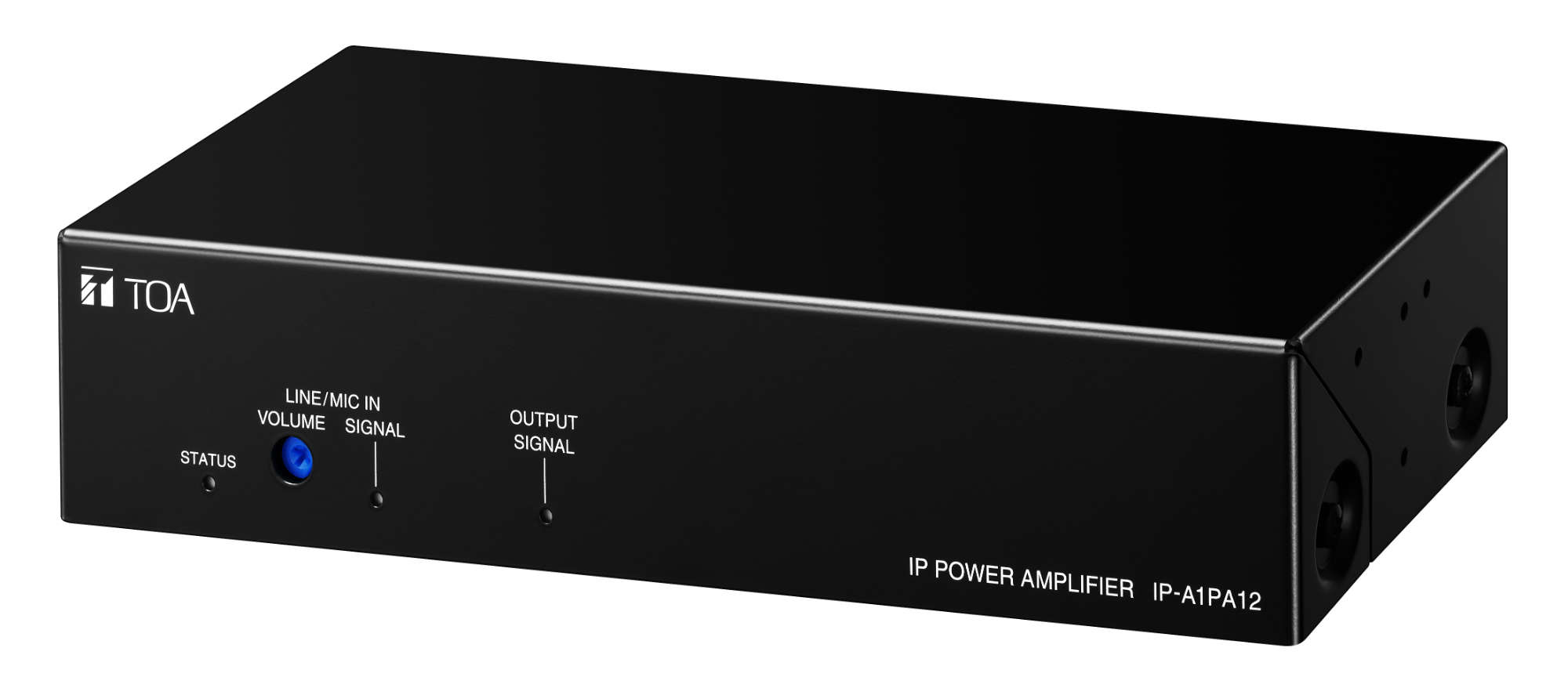IP-A1PA12
IP Power Amplifier 12W
IP-A1PA12
The IP-A1PA12 is a compact 12 W amplifier which is designed to amplify audio signals received through network. It is equipped with 25 V, 70 V and 100 V speaker line outputs to drive wide range of high impedance speakers. With an external amplifier input capability, speaker(s) can be driven by internal amplifier or external amplifier by switching over. It allows integrations with IP camera systems by using ONVIF protocol, paging from IP phone systems by using SIP protocol and group broadcast by multicast streaming. Max. 20 audio files can be registered and they can be played back by control inputs or remote API (HTTP/HTTPS) commands.
- 12W amplifier to drive 100/70/25V line speakers
- Receive SIP audio, ONVIF and Multicast
- Local broadcast using internal audio files or local audio source
- External amplifier input (100/70/25V) to share speakers between the built-in amplifer and external PA amplifier to be switched over
- 1 audio input (LINE/MIC selectable, phantom power On/Off)
- 2 control inputs, 1 control output and 1 mute control input
- HTTP/HTTPS commands (receive)
- Audio file storage (20 files, total 80MB, WAV/MP3)
- Playback programs (Repeat, Weekly Timer)
- PoE+ powered
3D Viewer / AR Simulator
6 W (IEC62368-1)
Multicast Broadcasting Mode: Opus/PCMU/PCMA/G.722 Auto codec recognition, 20 ports
VMS Broadcasting Mode: PCMU
Internal Message Broadcasting Mode
Local Broadcasting Mode: Output from LINE/MIC IN to SPEAKER OUT
Note: Each broadcast mode can be assigned an order of priority using the Priority Setting function.
Supported file formats
WAV file: 8/16/44.1/48 kHz sampling frequency, 8/16 bit, monaural/stereo
MP3 file: 32/44.1/48 kHz sampling frequency, 64 - 320 kbps, CBR/VBR, monaural/stereo
Repeat playback: Playcount (1 - 10 times), Duration (5 - 3600 sec) or Timer (from Start time to End time)
Interval time: 0 - 60 sec, Delay time: 0 - 30 sec
Trigger: Control Input or Remote API (HTTP/HTTPS)
Preset chime tone x 5, editable tone x 2
LINE/MIC selectable (Rated input: LINE: 0 dB (*2), MIC: -60 dB (*2)
PAD function (-20 dB (*2), Phantom power ON/OFF (12 V DC), volume adjustable removable terminal block (6 pins)
Rated input: 0 dB (*2), removable terminal block (6 pins)
N (100 V), N (70 V/25 V switchable), R, C removable terminal block (4pins)
N (100 V), N (70 V/25 V switchable), R, C removable terminal block (4pins)
Swithced to external amplifier when the following functions and operations are activated:
mute control input, control input, system mute, remote API control and the unit power off.
Rear chassis: Surface-treated steel plate
Wall mounting bracket: MB-15B (for wall mounting)
(*2) 0 dB = 1V
(*3) Not compatible with jointing 2 units using MB-15B-J.
*ONVIF is a registered trademark of ONVIF Inc.
*These specifications apply to the firmware verion 3.4.0 or later. For the latest specifications and firmware, please refer to the TOA DATA Library (https://www.toa-products.com/international/)
Please download Datasheet to access full specifications.
Rack mounting bracket: MB-15B-BK
Wall mountung bracket: MB-15B
manufactured by TOA Corporation
Manufacturer: TOA Corporation
Model: IP-A1PA12
Please sign in to access further technical materials such as software, firmware or EASE files.



